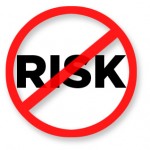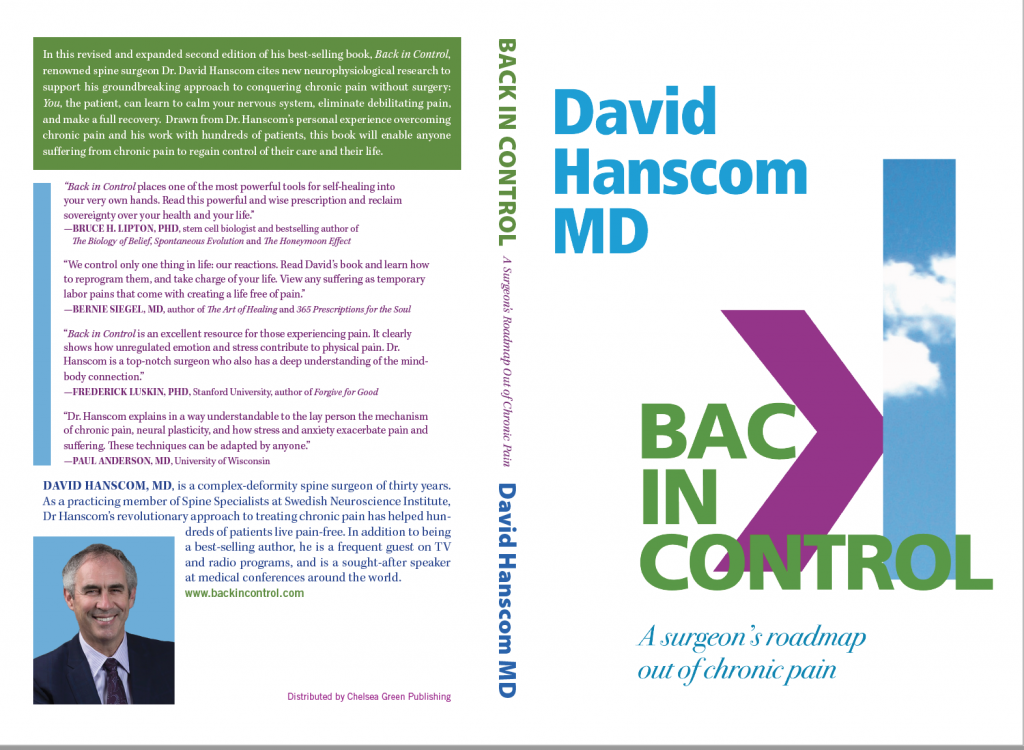The second edition of Back in Control: A Surgeon’s Roadmap Out of Chronic Pain will be available November 17th, 2016. Why did I write a second edition?
The first book was based on my personal experience and observing the successes with my patients. A great deal of new neuroscience research has since been published, which both supports my treatment approach and explains the reason for its success. Reading the neuroscience literature has deepened my understanding of how the process works. On a personal note, I also developed severe arthritis in both of my knees. About six months into my ordeal I realized that I had developed chronic pain. I re-engaged with these tools and have experienced a marked improvement in my symptoms.
Here are some of the concepts that I have learned through the literature and observation:
- Emotional pain and physical pain are processed in the brain in a similar manner and are equivalent entities. (1) They both cause the secretion of adrenaline and cortisol. When you feel anxiety you are simply feeling the this hormonal surge. Therefore, anxiety is a chemical reaction to sensory input and is not primarily a psychological issue. The Neurophysiologic Basis of Chronic Pain Most patients, given a choice of getting rid of their physical pain versus mental pain would rather get rid of their emotional pain. Fortunately, as anxiety drops, adrenaline and cortisol levels decrease and the physical pain will diminish. Stress chemicals increase nerve conduction and pain by 30 – 40%. (2) Anxiety, anger and adrenaline
- In the first edition, I was emphatic that surgery for a structural problem should be performed more quickly since people in chronic pain don’t tolerate additional pain. My experience and the literature do not support that idea. If you operate in the presence of a fired up nervous system, the pain will frequently worsen and often dramatically. I now have all of my elective spine surgery patients engage in the tools outlined in Back in Control for at least 8 to 12 weeks. Surgical outcomes have been more consistent with less pain after surgery and a faster rehab. I also am no longer seeing some of the dramatic failures from a well-done surgery like I saw in the past. The name for this preoperative rehab process is “prehab”. Video: Get it Right the First Time
- What has been the most surprising turn of events is that during the prehab process I have witnessed dozens of patients become pain free that have severe pathology with matching symptoms. I had scheduled each of them for surgery and they cancelled it because their pain dramatically decreased. They did not want or need surgery. I now realize that you can calm down and reprogram your nervous system any way that you want with consistent practice of these tools. It has been rewarding seeing patients become free of pain without the cost or risk of surgery. Avoiding surgery by raising the pain threshold
- I have changed the name of the DOCC (Defined Organized Comprehensive Care) project to the DOC (Direct your Own Care). My book is not a formula. It is a framework that breaks down chronic pain into its component parts and my patients find their own personal solutions. I have watched hundreds of patients become pain free with this largely self-directed process. If someone does not want to engage in these concepts, whether or not they use my book, they cannot and will not get better. The one factor that predicts a good outcome is being truly open to learning and using your personalized version of the tools. DOC-A framework of care
- Research shows that the writing and ripping up exercise does not have to express just negative thoughts. Writing down any thoughts and feelings, either positive or negative is effective. Expressive writing is still the foundation of the DOC project. (3) Write and don’t stop
- These concepts apply to pain from any source in any part of the body. Interestingly, as the process depends on decreasing adrenaline, pain in multiple body areas will disappear about the same time.
John
I had a middle-aged patient who had suffered a significant fracture of the middle part of his back. His spine was bent forward almost 45 degrees. However, since it was just at one level he was able to compensate and was still balanced with his head centered over his pelvis. I would have quickly recommended surgery for it for ten years ago. Then I found out he had been suffering from severe anxiety since he was ten years-old and sleeping poorly. I put him through the prehab process, which included expressive writing, active meditation, normalizing his sleep and getting him more physically active.
He was initially unhappy with me delaying surgery, which would have corrected the deformity. However, the medical literature is clear that surgical outcomes are compromised without the above-mentioned issues being treated. He came back a few times asking for the surgery but was not really engaging in the project. I finally said, “Look, you are welcome to find another surgeon, but I am not going to put you through surgery until these problems are least partially solved.”
He came in a few weeks later with a huge smile on his face. His pain was gone and his anxiety was beginning to decrease. He was sleeping much better and his whole personality was transformed. I will admit that I thought he was going to get his surgery done elsewhere. I am still endlessly surprised and fascinated when my patients come out of their pain pathways, although we witness it every week.
New format
The new edition is organized around following format:
- Section One – The Evolution of Chronic Pain
- Sections Two – The Principles Behind the Solution
- Section Three – The Roadmap Out of Chronic Pain
- Section Four – Continuing Your Journey
I am excited about the new edition. I have learned how to clearly present these concepts, since I have a better grasp of these principles. I am seeing a higher percent of people engaging and improving. This edition reflects that experience as well as the recent advances in neuroscience that support it. I am looking forward to seeing how this whole process unfolds and this new edition is the next step in my journey.
Am I operating on your pain or anxiety?
1. Eisenberger N. “The neural bases of social pain: Evidence for shared representations with physical pain.” Psychosom Med (2012); 74: 126-135.
2. Chen X, et al. “Stress enhances muscle nociceptor activity in the rat.” Neuroscience (2011); 185: 166-173.
3. Smyth JM and James Pennebaker. “Exploring the boundary conditions of expressive writing: In search of the right recipe.” British Journal of Health Psychology (2008); 13: 1-7.


